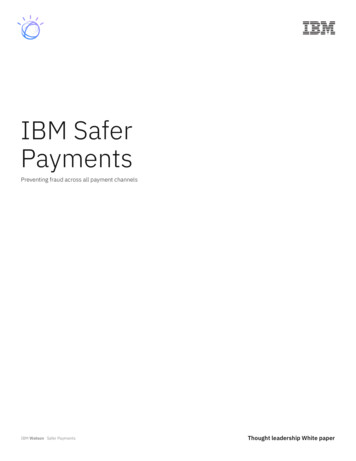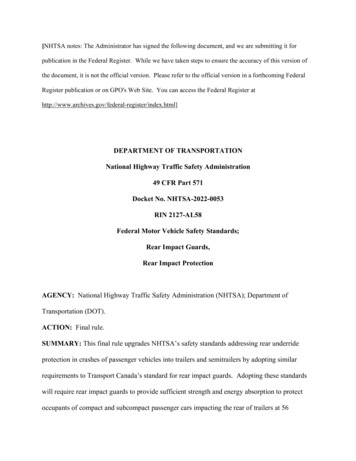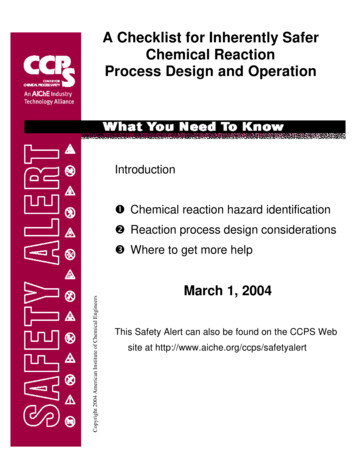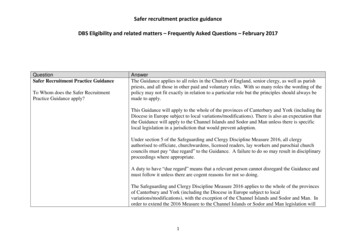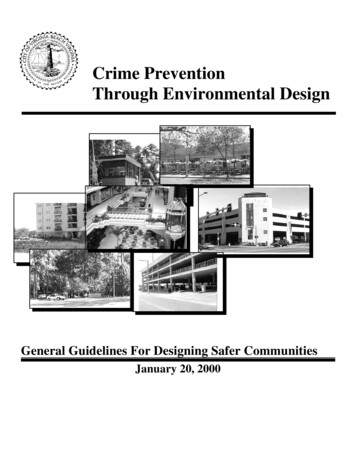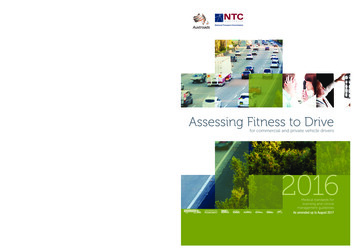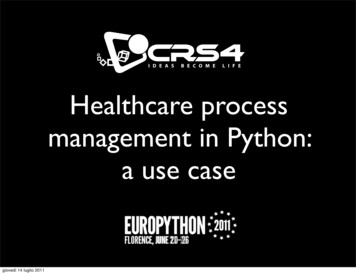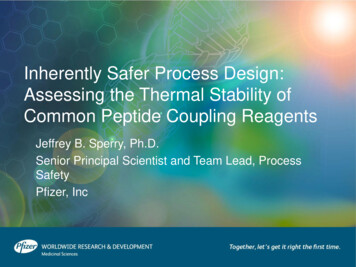
Transcription
Inherently Safer Process Design:Assessing the Thermal Stability ofCommon Peptide Coupling ReagentsJeffrey B. Sperry, Ph.D.Senior Principal Scientist and Team Lead, ProcessSafetyPfizer, Inc
Outline Inherently Safer Process Design in the Pharmaceutical Industry (5 min)Case Study: Peptide Coupling Reagents (15 min)Conclusions and Future Work (5 min)Questions (5 min)
Inherently Safer Process Design in the PharmaceuticalIndustry A study in 1989 by Barton and Nolan of incidents which occurred inbatch reactors revealed “a lack of understanding of the process beingcarried out” as one of the main causes In 2001, the CSB concluded that inadequate knowledge of systemsand inadequate hazard identification are still the main causes ofreactive chemistry incidentsBarton, J. A. and Nolan, P. F, 1989, Incidents in the Chemical Industry due to Thermal-Runaway Chemical Reactions,Hazards X: Process Safety in Fine and Specialty Chemical Plants, IChemE Symposium Series No.115: 3-18.
Inherently Safer Process Design in the PharmaceuticalIndustry A study in 1989 by Barton and Nolan of incidents which occurred inbatch reactors revealed “a lack of understanding of the process beingcarried out” as one of the main causes In 2001, the CSB concluded that inadequate knowledge of systemsand inadequate hazard identification are still the main causes ofreactive chemistry incidents Since 2001
Inherently Safer Process Design in the PharmaceuticalIndustry December 19th, 2007 T2 Laboratories Explosion (Jacksonville, FL) Cooling failure led to thermal runaway reactionThermal runaway not characterized during hazard analysisNo evidence T2 performed required HAZOP before scale-up4 deaths and 14 ctive-chemical-explosion/
Inherently Safer Process Design in the PharmaceuticalIndustryFor the reaction:R1 R2P
Inherently Safer Process Design in the PharmaceuticalIndustryFor the reaction:R1 R2Hazards associated with R1, R2 and PP– Thermal stability Onset temperatureHeat of decompositionAdiabatic temperature riseTMR, TD24– Impact and friction sensitivity– Explosivity– Combustible dust hazards (MEC, LOC, MIE, MIT, KST, chargeability, etc.)
Inherently Safer Process Design in the PharmaceuticalIndustryFor the reaction:R1 R2P
Inherently Safer Process Design in the PharmaceuticalIndustryReagent (R)For the reaction:R1 R2Solvent (S)Temp (T)Pressure (P)P
Inherently Safer Process Design in the PharmaceuticalIndustryReagent (R)For the reaction:R1 R2Solvent (S)Temp (T)Pressure (P)Hazards associated with R1, R2 and P AND R and S– Thermal stability ––––––Onset temperatureHeat of decompositionAdiabatic temperature riseTMR, TD24Impact and friction sensitivityExplosivityCombustible dust hazards (MEC, LOC, MIE, MIT, KST, chargeability, etc.)Heat of ReactionAssociated pressure riseAll credible maloperationsP
Inherently Safer Process Design in the PharmaceuticalIndustryReagent (R)For the reaction:R1 R2Solvent (S)Temp (T)Pressure (P)P
Inherently Safer Process Design in the PharmaceuticalIndustryReagent (R)For the reaction:R1 R2Solvent (S)Temp (T)Pressure (P)What about byproducts?Regent (R)XP
Inherently Safer Process Design in the PharmaceuticalIndustryReagent (R)For the reaction:R1 R2Solvent (S)Temp (T)Pressure (P)What about byproducts?Regent (R)What are the hazards associated with X? Thermal stability Explosivity Shock sensitivity ToxicityXP
Case Study: Peptide Coupling ReagentsPeptide Coupling:
Case Study: Peptide Coupling ReagentsPeptide Coupling: 180 C
Case Study: Peptide Coupling ReagentsPeptide Coupling: 180 CLorlatinib
Case Study: Peptide Coupling ReagentsPeptide Coupling: 180 CLorlatinib
Case Study: Peptide Coupling ReagentsPeptide Coupling:X 180 CLorlatinib
Case Study: Peptide Coupling ReagentsPeptide Coupling:
Case Study: Peptide Coupling ReagentsPeptide Coupling:PeptideCouplingReagent
Case Study: Peptide Coupling ReagentsPeptide Coupling:PeptideCouplingReagent0 to 60 C
Case Study: Peptide Coupling ReagentsPeptideCouplingReagentPeptide Coupling:0 to 60 CMechanism:PeptideCouplingReagentActivatedEster
Case Study: Peptide Coupling ReagentsPeptideCouplingReagentPeptide Coupling:0 to 60 tide coupling reagent determines “A*”
Case Study: Peptide Coupling ReagentsJ. R. Dunetz, et al. Org Process Res Dev, pp 140-170, 2016
Case Study: Peptide Coupling Reagents In this presentation:– Studied 45 of the most common peptide coupling reagents used inthe pharmaceutical industry Differential Scanning Calorimetry– Left-limit onset temperature– Quantitative heat of decomposition– Yoshida Correlation (Shock sensitivity and explosivity)– Goal: Drive Inherently Safer Process Design
Case Study: Peptide Coupling Reagents Differential Scanning Calorimetry
Case Study: Peptide Coupling Reagents Differential Scanning CalorimetryAdvantages Small sample size (2-5 mg)Fast turnover ( 2 hours/sample)Quantitative heat of reaction/decompositionDisadvantages Small sample size - unrepresentative Peaks shift with varying rate Onset temperatures can be 100 C lower thanexpected from DSC Isothermal, not adiabatic
Case Study: Peptide Coupling Reagents
Case Study: Peptide Coupling ReagentsMelt
Case Study: Peptide Coupling ReagentsLeft limit onsettemperature
Case Study: Peptide Coupling ReagentsEnergy ofdecomposition
Case Study: Peptide Coupling Reagents The Yoshida Correlations:– Mathematical equations that correlate a materials onset temperature and energy from a DSCexperiment to its ability to propagate an explosion and/or be shock sensitive– For explosive propagation (EP):EP log (QDSC) – 0.38 x log(TDSC – 25) – 1.67– For shock sensitivity (SS):SS log (QDSC) – 0.72 x log(TDSC – 25) – 0.98QDSC is the energy of the exotherm in cal/gTDSC is the onset temperature of the exotherm in CIf EP or SS 0 material is predicted to demonstrate the ability to propagate an explosion or beshock sensitiveWada, Y.; Foster, N.; Yoshida, T. Safety of Reactive Chemicals and Pyrotechnics, Elsevier Science, 1995.
Case Study: Peptide Coupling Reagents
Case Study: Peptide Coupling Reagents“Pfizer-Modified” 25% conservation factor applied to Yoshida Correlation
Case Study: Peptide Coupling lfonyl ChlorideMsCl121-Isobutoxycarbonyl- 2isobutoxy- 1,2-dihydroquinolineIIDQ2p-Toluenesulfonyl ChlorideTsCl131-tert-Butoxy- 2butoxycarbonyl- 1,2dihydroisoquinolineBBDI3Phosphorous T4Oxalyl Chloride(COCl)2154- (4,6- Dimethoxy- 1,3,5-triazin 2-yl) - 4-methylmorpholiniumchlorideDMTMM162-Chloro- 4,6- dimethoxy- 1,3,5triazineCDMT17N- (3-Dimethylaminopropyl) rolidinophosphonium hexafluorophosphatePyClOP5n-Propanephosphonic AcidAnhydride (50% solution in ′-Disuccinimidyl carbonateNDSC8Pivaloyl ChloridePivCl9Ethyl chloroformateECF1011Isobutyl chloroformate2-Ethoxy- 1-ethoxycarbonyl- 1,2dihydroquinolineIBCFEEDQ
Case Study: Peptide Coupling nzotriazol- 1yloxy) iumhexafluorophosphatePyClU352-Chloro- 1,3-dimethylimidazolidinium hosphinicchlorideBOPCl36O- [(Ethoxycarbonyl) cyanomethylenamino] -N,N,N′,N′tetramethyluronium tetrafluoroborateTOTU26Diphenylphosphinic chlorideDppCl37O- (6-Chlorobenzotriazol- 1-yl) teHCTU27Diethyl chlorophosphateDEPC38O- (6-Chlorobenzotriazol- 1-yl) TCTU28Diphenyl henyl phosphoryl oxy)dimethylaminomorpholino-carbenium hexafluorophosphateCOMU30Pentafluorophenyl iumtetrafluoroborate43O- (5-Norbornene- 2,3-dicarboximido) -N,N,N′,N′tetramethyluronium benzotriazol-1yl)uronium um 3-oxidehexafluorophosphateHDMAO- (Benzotriazol- 1-yl) -N,N,N′,N′tetramethyluronium alimide tetramethyluroniumhexafluorophosphateCITU3233
Case Study: Peptide Coupling ReagentsEntryReagentAverage Major Left LimitOnset ( C)Average TotalExothermic Energy (J/g)Yoshida Shock(S)Explosive ( E 763S/E8PivClNo observed exothermNo observed exothermN/A9ECF136-344N/A10IBCF113-470N/A
Case Study: Peptide Coupling ReagentsEntryReagentAverage Major Left LimitOnset ( C)Average TotalExothermic Energy (J/g)Yoshida Shock(S)Explosive ( E 20-549N/A18DIC252-410N/A19DCC254-269N/A
Case Study: Peptide Coupling ReagentsEntryReagentAverage Major Left LimitOnset ( C)Average TotalExothermic Energy (J/g)Yoshida Shock(S)Explosive ( E 1N/A26DppClNo observed exothermNo observed 56N/A30FDPPNo observed exothermNo observed exothermN/A
Case Study: Peptide Coupling ReagentsEntryReagentAverage Major Left LimitOnset ( C)Average TotalExothermic Energy (J/g)Yoshida Shock(S)Explosive ( E 127-736N/A
Case Study: Peptide Coupling ReagentsEntryReagentAverage Major Left LimitOnset ( C)Average TotalExothermic Energy (J/g)Yoshida Shock(S)Explosive ( E 44HDMA151-1083S/E45CITU181-395N/A
Case Study: Peptide Coupling ReagentsEntryReagentAverage Major Left LimitOnset ( C)Average TotalExothermic Energy (J/g)Yoshida Shock(S)Explosive ( E 44HDMA151-1083S/E45CITU181-395N/AOf the 45 peptide coupling reagents: 7 had at least 1 experiment that flagged as potentially shock sensitiveNDSC, PyBOP, TDBTU, TBTU, TCTU, HATU, HDMA
Case Study: Peptide Coupling ReagentsEntryReagentAverage Major Left LimitOnset ( C)Average TotalExothermic Energy (J/g)Yoshida Shock(S)Explosive ( E 44HDMA151-1083S/E45CITU181-395N/AOf the 45 peptide coupling reagents: 7 had at least 1 experiment that flagged as potentially shock sensitiveNDSC, PyBOP, TDBTU, TBTU, TCTU, HATU, HDMA 12 had at least 1 experiment that flagged as potentially explosiveNDSC, PyBOP, TDBTU, TBTU, TCTU, HATU, HDMA, PyAOP, DMTMM, TNTU, TPTU, HBTU
Case Study: Peptide Coupling Reagents
Case Study: Peptide Coupling Reagents
Case Study: Peptide Coupling ReagentsReagents that flagged as potentially shock sensitive:
Case Study: Peptide Coupling ReagentsReagents that flagged as potentially explosive:
Case Study: Peptide Coupling ReagentsReagents that flagged as potentially explosive:
Case Study: Peptide Coupling ReagentsReagents that flagged as potentially explosive:These reagents contain known High-Energy Functional Groups (HEFGs)
Case Study: Peptide Coupling Reagents
Case Study: Peptide Coupling ReagentsHOBt, dry, Koenen test at 10mmHOBt, dry, detonation test (UN test A.1)HOBt with 50% water, Koenen test at 2.0 mmWehrstedt, K. D.; Wandrey, P. A.; Heitkamp, D. J. Hazard. Mater. 2005, 126, 1.
Case Study: Peptide Coupling ReagentsPeptide Coupling:Peptide Coupling Reagent
Case Study: Peptide Coupling ReagentsPeptide Coupling:
Case Study: Peptide Coupling ReagentsPeptide Coupling:
Case Study: Peptide Coupling ReagentsPeptide Coupling:HOBtMW 135.13 g/mol1.1 equiv.Carboxylic AcidMW 250 g/mol1.1 equiv.AmineMW 150 g/mol1.0 equiv. (LR)HBTUMW 379.25 g/mol1.1 equiv.Desired ProductMW 382 g/mol1.0 equiv.For a 10 g reaction (based on LR): 9.9 g of HOBt will be produced (Laboratory Scale)For a 1 kg reaction (based on LR): 991 g of HOBt will be produced (Kilo-lab Scale)For a 10 kg reaction (based on LR): 9.91 kg of HOBt will be produced (Pilot Plant Scale)For a 100 kg reaction (based on LR): 99.1 kg of HOBt will be produced (Commercial Scale)
Case Study: Peptide Coupling ReagentsPeptide Coupling:HOBtMW 135.13 g/mol1.1 equiv.Carboxylic AcidMW 250 g/mol1.1 equiv.AmineMW 150 g/mol1.0 equiv. (LR)HBTUMW 379.25 g/mol1.1 equiv.Desired ProductMW 382 g/mol1.0 equiv.For a 10 g reaction (based on LR): 9.9 g of HOBt will be produced (Laboratory Scale)For a 1 kg reaction (based on LR): 991 g of HOBt will be produced (Kilo-lab Scale)For a 10 kg reaction (based on LR): 9.91 kg of HOBt will be produced (Pilot Plant Scale)For a 100 kg reaction (based on LR): 99.1 kg of HOBt will be produced (Commercial Scale)Unless reaction is quenched with an aqueous solution, HOBt will be generated as an anhydrous solution in an organicsolvent
Case Study: Peptide Coupling ReagentsPeptide Coupling:HOBtMW 135.13 g/mol1.1 equiv.Carboxylic AcidMW 250 g/mol1.1 equiv.AmineMW 150 g/mol1.0 equiv. (LR)HBTUMW 379.25 g/mol1.1 equiv.Desired ProductMW 382 g/mol1.0 equiv.The generation of anhydrous HOBtmust be thoroughly assessed duringthe Process Safety ReviewHOBt, dry, Koenen test at 10mmHOBt, dry, detonation test (UN test A.1)HOBt with 50% water, Koenen test at 2.0 mm
Case Study: Peptide Coupling ReagentsOr better yet Can we develop processes that AVOID the use of HOBt and HOAt-basedcoupling reagents?
Case Study: Peptide Coupling ReagentsOr better yet Can we develop processes that AVOID the use of HOBt and HOAt-basedcoupling reagents?Answer: We can and we should!
Case Study: Peptide Coupling ReagentsMost PPDPCFDPPCIPTFFHUse with CautionECFIBCFTSTULeast TUCOMUHATUTNTUHDMAPyBOPPyAOP* Based on thermal stability data of the peptide coupling reagent and generation of hazardous by-products. Every process should bethoroughly assessed by professionally trained Process Safety scientists
Future Work All shock sensitivity testing has been completedAll explosivity testing has been completedAll adiabatic testing has been completed Get manuscript published!!
AcknowledgementsProcess Safety Labs (Groton, CT)Rich BarnhartDave BillRemzi DuzgunerBob GiustoChris MinteerLivia TaoJohn WeaverProcess Safety Labs (Sandwich, England)Mike HawksworthRebecca JohnsonSam OkePfizerPaul RichardsonIain GladwellCharlie Santa MariaJerry Weisenburger
Questions?
reactive chemistry incidents Inherently Safer Process Design in the Pharmaceutical Industry Barton, J. A. and Nolan, P. F, 1989, Incidents in the Chemical Industry due to Thermal-Runaway Chemical Reactions, Hazards X: Process Safety in Fine and Specialty Chemical Plants, IChemE Symposium Series No.115: 3-18.
